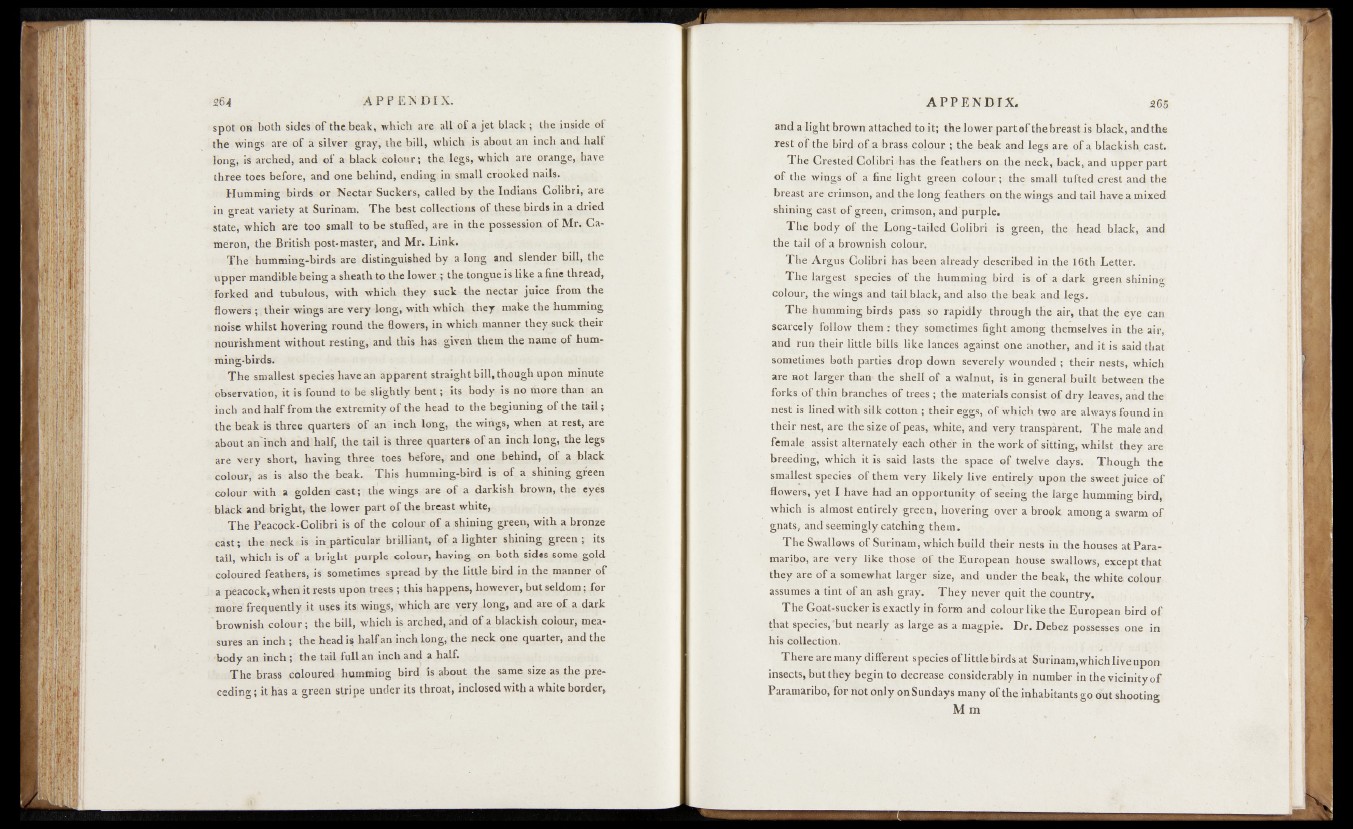
spot oh both sides of the.beak, which are all of a je t Mack;; the inside of
the wings are of a silver gray! the bill, which is about an inch and half
long, is arched, and of a black Colour; the,legs* which are orange, have
three toes before, and one behind, ending in small crooked nails.
Humming birds or Nectar Suckers, called by the Indians Golibri, are
in great variety at Surinam. The best collections of these birds in a dried
state, which are too small to be stuffed, are in the possession of Mr; Cameron,
the British post-master, and Mr. Link.
The humming-birds are distinguished by a long and slender bill, the
up p e r mandible being a sheath to the lower.; the.-tongue.is like a fine thread,
forked and tubulous, with which they suck the nectar juice from the
flowers r, their wings are very long, with which they make the humming
noise whilst hovering round the flowers, in which manner they suck their
nourishment without resting, and this has- giveh them the name of humming
birds.
The smallest species have an apparent straight bill, though upon minute
observation, it is found tb’be slightly bent ; its body is no thore than an
inch and half from the extremity of the head to the beginning of the tail;
the beak is three quarters of an inch long, the wirtgs, when at rest, are
about an inch and half, the tail is three quarters of an inch long, the legs
are very short, having thiree toes before, and one behind, of a black
colour, as is also the beak./ This humming-bird is; shining green
colour with a golden cast; the wings are o f a darkish brown, the eyes
black and bright, the lower part of the breast white,
The Peacock-Colibri is of the colour of a shining green, with a bronze
cast;; :the:; neck !,is >in particular brilliant, o f a lighter shining green ; its
tail, which is of a bright purple colour, having on both sides som? gold
coloured feathers, i f sometimes spread by the iit|le ,bird in the manner of
a peacock, when it rests upon trees; this happens, however, but seldom; for
more frequently it uses its wings, which are very .long, and are of a dark
brownish colour; the bill, which is arched, and of a blackish colour* measures
an inch j the head is half an inch long, the neck one quarter, and the
•body an in ch ; the tail full an inch and a half.
The, brass .coloured humflaing bird is about the same size as the preceding;
it has a green stripe under its throat, inclosed with a white border,
and a light brown attached to it; the 1 ower part of the breast is black, and the
j e s t o f the bird of-ahrasSfCpl'Qur ; the beak and legs are df a blackish, cast;
The Crested CoHhrrihas^t|ie. featheraion. tb%neck, back, and upper part
of the wipgs of a fine light grqen;dplqur/,utlie: siqall tufted cfest and the
breast are crimson, and,the longr.feathers .on the wings, and tail have a mixed
shining cast of green, crimson,'and purple.
The body of the Long-tailed Gplibri is greqn^the head black, and
the tail o f a. brownish colour, n
j T he »A rgq s 'Qollhii h as been already described in the Letter, t
■ The largest, species of t|le huinming.bi,rdtr:issof, a dark green shining
colour, the wings and tail black? and also the, beak andl-egs,
The humming birds pass,, so rapidly through the air, that the eye can
scarcely follow them: they sometimes fight among themselves in the air,
and run their little bills, like lances against ©ne.another, and it is said that
sometimes both parties drop down severely wounded ; .their nests, which
are hot larger, than'the shell o f a Walnut, is in general built between the
forks of thin+bjranches of trees; the materials consist, of^dry leaves, and the
nest is linedwith silk cotton ; their eggs, of which two are always forint in.
their nest, are the size of peas, white, and very transparent. The male and
female, assist alternately each other in the work o f sitting? whilst, they are
breeding, which it is said lasts the space of twelve days'. Though the
smallest species of them very likely live entirely upon the sweet juice o f
flowers, yet I have had an opportunity o f seeing the large humming bird,
which is almost entirely green/ hovering over a brook among a swarm of
gnats, and seemingly catching them.
The Swallows of Surinam, whichibuild their ngsts in the houses at Paramaribo,
are very like those of the European house swallows* except that
they are of a somewhat larger size, and under the beak, the white, colour
assumes a tint o f am ash gray. They never quit the.country.
The Goat-sucker is exactly in form and colour like the European bird o f
that species,'hut nearly as large as a magpie. Dr. Debez possesses, one, in
his collection.
There are many different species of little birds at Surinam,which live upon
insects, but they begin to decrease considerably in number in the .vicinity o f
Paramaribo, for not only on Sundays many of the inhabitants go Out shooting
M m